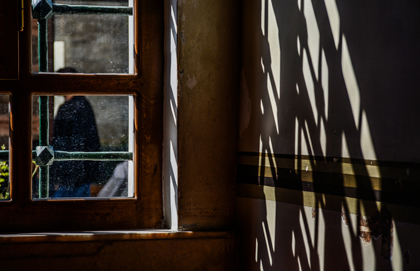In September 2011, I joined the sisters of my congregation on mission in Marguerite Bourgeoys' native city: Troyes, France. That moment began an adventure, an entry into new spaces — language, culture, country.
During my first year there, with Sisters Gervaise Deschênes and Rachel Gaudreau and Annie Kobik, CND Associate, I helped shape what is now our contemporary, dynamic bilingual centre known as Marguerite Bourgeoys' Space. I also led prayer and reflection groups on various themes drawn from my personal writings in the light of contemporary Church and society, and welcomed visitors.
Having lived and worked for several years in Montreal, I have often walked in Marguerite's footsteps in Old Montreal and prayed in Notre-Dame-de- Bon-Secours Chapel, which she established in 1675, on St. Paul Street. In Troyes, I walked the streets of Marguerite's early life, stood before or entered places that marked significant moments in her life, visited and prayed in churches she frequented before she left for Ville-Marie (now Montreal) in 1653, when she was 33 years old. On a journey, you can walk over the land or you can allow the land to enter you. In the latter case, the journey becomes a pilgrimage, opening you to what the land and its places wish to speak to your heart.
There is much that I could share with you. Perhaps it would be best to zoom in, as one does when taking a photo, on one event that set the pilgrimage afloat.
A few days after arriving, I found myself, with Sisters Deschênes and Gaudreau, preparing the celebration of the Eucharist that would mark the 30th anniversary of the arrival of our sisters in Troyes in October 1981, a year prior to Marguerite's canonization in October 1982.
This joy-filled celebration of the people of God at the Eucharist on the evening of October 5 spoke largely of their appreciation for all that Marguerite, a native of Troyes, represented and for the presence of our sisters in their midst over the years.
The celebration was held in St-Jean-au-Marché, Marguerite's parish church, where she was baptized, becoming a member of the Christian community on April 17, 1620. Marguerite, in her writings, expressed her gratitude for the gift of this moment in her life.
Subsequent moments in St-Jean — at celebrations of the Eucharist, at evening prayer, afternoons welcoming tourists into this church that dates from the first half of the 13th century — have left their mark on me. (Marguerite's family home and that of her grandparents were a few metres from the church.) I have often wondered what place she took in this church. Am I in her place? Nearby, perhaps? Of course, the answer eludes me. However, the church's interior beauty cannot be lost on you, as it must not have been lost on Marguerite — evidence of a people who left their paintings, stained glass windows and sculptures that depict stories of the unfolding of Christianity, the courage of Christians through the centuries, as an inspiration for generations to come.
St-Jean-au-Marché houses local artist François Girardon's 16th century sculpture of Mary, the mother of Jesus, visiting her cousin Elizabeth, a moment Luke calls the Visitation in his Gospel. We know that Marguerite's spiritual director told her that this image of Mary represented a woman on a journey. He added that no one had tried to imitate this image of Mary, which became a popular image in the 17th century French School of Spirituality.
We see two women, clothed in 16th century contemporary dress, clutching each other's hand. If you are fortunate to be there when the sun shines through the adjacent window onto Mary's face, Elizabeth's face before her becomes illuminated as well. Time stands still. You are drawn into the encounter of these two pregnant women, life quickening within, drawing forth life in each other, announcing the good news that Jesus will be for the world.
This image of Mary and Elizabeth in the Visitation is also represented in the midst of the colourful stained glass windows in the 14th century St-Remy church a few streets away. (Marguerite's parents were married there.) On its right is the stained glass window depicting Mary in the midst of the Apostles, the men and women disciples of Jesus at Pentecost. Empowered by the Spirit, they set forth on a journey of encounter, to share with others all that faith in Jesus offered. The sculpture of the Visitation in St- Jean-au-Marché church and its parallel image, along with that of Pentecost, in the stained glass windows in St-Remy offer an image of how Church should be lived — offer all Christians a way of being Church in today's world.
Whether I am in St-Jean-au-Marché, the sculpture of the Visitation before me, or in St-Remy at morning Eucharist, the stained glass windows of Visitation-Pentecost behind the altar, I am led to ponder their ever deepening influence on Marguerite, which inspired her way of being that led to the foundation of our congregation in 17th century Montreal. Their spirit forms the heart of our spirituality — who we are called to be as women who walk in Marguerite's footsteps, along with almost 900 women and men associates of our congregation in various parts of the world.
As a Christian, these privileged moments in Troyes, have encouraged me to ponder my own encounters, fleeting moments in time or genuine moments of presence to the other, attentive to the Spirit alive in each person, all creation, pulsing life.
Shortly after arriving on mission in Troyes, I went to the government buildings known as the Prefecture, visa in hand, to apply for my residency permit. I had to return to the building several times over the next year to obtain, then renew my permit.
At each visit, waiting for my number to be called, I was conscious of the people around me from countries beyond Europe's borders, seeking residency in Troyes. What were their stories, I wondered. What circumstances led them to leave their countries to settle in a foreign land? Sitting in their midst, I remember being mindful of countless persons today fleeing war-torn countries, seeking refuge, a safe place to live. So many men, women, children on the move.
Looking back, I realize that my visits to the Prefecture were focused on getting my residency permit. Today, my heart knows what before were simply facts: each time I walked on the grounds and entered the Prefecture, I was walking on land and entering space that holds a sacred story.
Originally the land held the Benedictine Abbey, Notre-Dame-aux-Nonnains, which dates from the seventh century. St-Jacques, the Dominican church, stood behind the monastery gardens. Both the abbey and the church were partially destroyed at the time of the French Revolution. The central section that remained became an administrative building. After the Revolution, it was transformed into government offices: the Prefecture. The city of Troyes has ensured that its heritage is not lost. When the building was destroyed by fire in 1892, it was reconstructed according to its original design.
Towards the end of her life, Marguerite Bourgeoys, in her Autobiography, made it clear that the abbey and the church remained a sacred memory for her. On Sunday, October 7, 1640, Marguerite joined the procession in honour of Our Lady of the Rosary at the Dominican church. Since the group was too large for the cloister, they crossed the street and passed in front of the portal of the Benedictine Abbey, where a stone statue of Mary stood above the door. That day, Marguerite glanced up at the statue and found it very beautiful.
This wasn't the first time Marguerite had seen this statue. But this time was different. She saw the statue with new eyes. In that moment, she had the spiritual experience that changed her life. She tells us that she found herself so moved and so changed that she no longer recognized herself. When she returned home, this was apparent to everyone.
Experiences similar to that of Marguerite usually manifest their authenticity in one's day-to-day behaviour. Until then, Marguerite had been a young woman who liked pretty clothes, was frivolous and popular with other young women. Now, she set those needs aside and became a woman focused totally on placing herself in God's service.
We might name this moment in Marguerite's life a touchstone experience. A touchstone is a stone used to test the purity, the quality, of gold or silver. As her life unfolded, I wonder how often the memory of the experience on that October 7 Sunday was a touchstone for her to test the authenticity of other experiences, other choices she was called to make.
Comparisons are odious, but reflection on Marguerite's experience has led me to ponder my own journey. Is there an experience in my life that is the touchstone against which I test the authenticity of other experiences, other decisions? What about you?
Some time after the October 7 experience, Marguerite crossed the portal that opened onto the monastery and school of the cloistered women's community, Congrégation de Notre-Dame (Canonesses of St. Augustine). There she joined a group of young women attached to the congregation that until that moment had held no attraction for her.
These young women, known as the Extern Congregation, were trained to teach the impoverished children in Troyes who could not afford an education. The children were given not only a Christian education but also the skills needed to take their place in society: a novel idea at the time.
Sister Louise de Sainte-Marie, the sister of Paul de Chomedey de Maisonneuve, founder of Ville- Marie, was the director of the group known as the Congréganistes. Marguerite heard often about the sisters' desire to establish a monastery of their congregation in Ville-Marie. She even agreed to go with them when their desire came to fruition. Little did Marguerite realize that she would go to Canada alone with Sister Louise's brother in 1653 to open the first school in Ville-Marie.
Today, the congregation's buildings in Troyes have been replaced by those of the Gendarmerie Nationale. Only one limestone wall exists of the original buildings. Yet the current structures are reminiscent of the past.
Recently, with volunteers from Marguerite Bourgeoys' Space, I had the opportunity to enter these grounds, which are closed to the public. One of our volunteers lives there with her husband, a gendarme, and their three sons. Once again, I knew I was on land that holds a sacred story not only of the sisters and the young women of Marguerite's time but also of Marguerite herself.
That June day, I wondered how many times Marguerite had crossed that portal to meet with the other young women and with Sister Louise? What did she carry in her heart? Was the enthusiasm she felt to place her life entirely in God's service mingled with moments of sadness, of disappointment?
In spite of her great desire to give her life totally to God, Marguerite was refused entry by the cloistered Carmelites. Her efforts to join other religious communities didn't come to fruition either. The reasons are unclear. In 1644, Marguerite and two companions tried to found a community of non-cloistered women who would go among the people, serving them in the spirit of Mary, who had gone in haste to visit her cousin Elizabeth. This Gospel story represents Mary as a woman en route, always turned towards her neighbour. For Marguerite, it offered a way of being in service to people beyond marriage and cloistered life, the main options for women of her day. She took this option seriously.
The experiment, which started at the instigation of Father Antoine Gendret, Marguerite's spiritual director, failed. Its duration is unclear: one woman died; the other left. Marguerite did not realize that this failure in Troyes would lead to her founding, in the same spirit, the Congrégation de Notre-Dame of Montreal, the first non-cloistered community of apostolic educators in North America.
It does ring true, however, that certain events in life prepare the future long before it happens. Knowing Marguerite's life story, we understand that another life was waiting for her, not yet ready to manifest itself.
After the project failed, Marguerite lived alone in a space within Hôtel du Chaudron that Jacqueline de Bouvot de Chevilly placed at her disposal. I spent some time in front of the portal of Hôtel du Chaudron, on rue Chrétien de Troyes. This portal, probably all that remains from Marguerite's time, would have provided her access to where she lived. I imagined her there alone, going in and out of her residence while remaining committed to the Extern Congregation.
Is it presumptuous to imagine that this time alone provided Marguerite solitude and silence in which to reflect on all that had unfolded in her life from 1640 until then in relation to her deep desire to give her life totally to God's service? Solitude and silence are also said to create the inner space needed to let go of personal desires in order to listen to the call inviting us to cross thresholds opening onto new horizons. Marguerite's "yes" to de Maisonneuve's invitation in 1652 to accompany him to Canada to become Ville-Marie's first teacher suggests this is so. (Her father, whom she held dear, had died suddenly just a year previously.)
Before the portal of Hôtel du Chaudron, reflecting on Marguerite's experience, I was conscious of the twists and turns in my own life, even leaving Montreal for Troyes. Times of solitude and silence; thresholds crossed, indeed.






